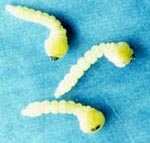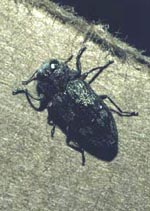Flat-Headed Apple Tree Borer
Chrysobothris femorata

Figure 1. Flat-Headed
Apple Tree Borer Larvae
Description
The adult borer is flat, dark metallic brown and about 1/2 inch long. Full grown larvae can be 1 1/4 inch in length. The eggs are yellow and disk-like. The adult body is very blunt at the head and tapers to a rounded point at the posterior end. The larvae are yellow to yellowish white, legless, slender grubs with large flat heads

Figure 2. Flat-Headed
Apple Tree Borer Adult
Life History
The borer will attack many species of trees and shrubs including maple, oak, sycamore, tulip, poplar, willow, rose, and cotoneaster. Newly transplanted trees and shrubs or plants that are stressed are particularly susceptible to attack. The adult female lays her eggs in bark crevices and the legless larva enters the bark at that point. If the plant is healthy, the larva may be killed by heavy sap flow. If not, it bores in to the inner phloem, forming irregular tunnels and partially filling them with powder-like frass. When nearly mature, in either spring or fall, the larva bores into the heartwood and pupates. Adults feed at the base of twigs, on partially defoliated trees. There is one generation per year.

Figure 3. Flat-Headed
Apple Tree Borer Damage
Damage
The borer is particularly damaging to trees in the first 2-3 years after transplanting. Droughts, pruning wounds, sunscald or frost injury all contribute to the problem and provide ready access to the tree by the borer. The borer can also be quite destructive in nurseries and orchards where grass and woody vegetation is allowed to grow around the base of the tree.

Figure 4. Flat-Headed
Apple Tree Borer
Damage on Maple
Nonchemical Control
Keeping trees healthy and prevention of wounds, sunscald or drought stress can greatly reduce borer attacks. Trees should be mulched and fertilized in order to keep them vigorous. Vegetation should be removed from around the base of trees and accompanied with clean cultivation.
Chemical Control
Insecticidal sprays.may be applied in early summer when adults emerge with a repeat application 3 weeks later.